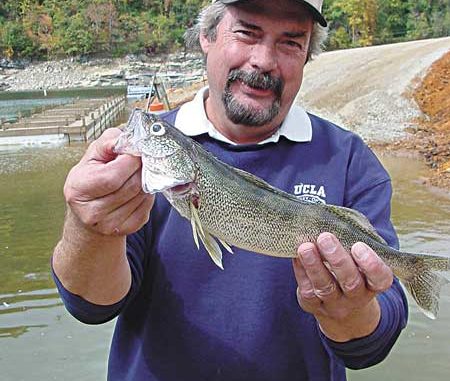
Walleye long have been one of the most-prized fish to eat in mountain lakes.
Most western North Carolina lakes have good populations of walleye, especially Fontana Reservoir and Santeetlah Lake.
Many anglers prefer walleye over trout; they’re that tasty.
But during September, the N.C. Division of Public Health issued a fish consumption advisory that stated walleye from Fontana and Santeetlah have unsafe concentrations of mercury. Health officials advised pregnant women, women who may become pregnant, and children under 15 not to eat any walleye from the lakes.
Other people who choose to eat walleye were advised to limit consumption to one meal a week (6 ounces of cooked fish).
County officials in Graham County immediately called for public hearings to determine the extent of the contamination and find out how the mercury got into the lake. All of Santeetlah and much of Fontana are in Graham County.
“I’ve heard a lot of concern, and we should settle some of the concerns people have,” said Graham County commissioner Billy Cable to a reporter from The Graham Star. “I’d like to know how this got into the water.”
Alicia Parham, county health director, said the state hadn’t released enough information about the problem.
“I’m still trying to get good information about it,” she said.
Regardless of official puzzlement, identifying the source of mercury pollution is easy. Stopping the pollution will be difficult.
Coal-fired electric plants are the primary source of mercury pollution, and most U.S. power plants are exempt from the pollution controls mandated by the Clean Air Act. Other sources include municipal, medical and hazardous waste incinerators.
The contaminant is released into the air and much of it settles into the earth’s soil. Contaminants eventually are washed into streams, rivers and lakes. Bacteria in the water convert mercury into a powerful and persistent neurotoxin, which works its way up the food chain from plankton and insects to fish, birds and mammals. When fish such as walleye, catfish, and carp consume contaminated aquatic life, mercury accumulates in the fish’s fatty tissue and stays there.
Exposure to mercury can cause serious problems to the central nervous system. Children and babies are particularly vulnerable.
N.C. Wildlife Resources Commission biologists provided the fish for the sampling, and state health officials tested the samples during July. The sampling showed that walleye from Santeetlah had the highest concentrations of mercury, 0.59 milligrams per kilogram to 1.4 milligrams, more than double what is considered safe. Fontana walleye mercury concentrations ranged from 0.3 milligrams to 1.7 milligrams. The health department considers 0.4 milligrams per kilogram an acceptable level of contamination.
Mallory Martin, WRC western region fisheries supervisor, said only walleye were tested for mercury. He said walleye are more susceptible to mercury contamination because of their diets and the fact they live longer than most fish.
High levels of mercury also have been found in black crappie, catfish, largemouth bass, warmouth and yellow perch. Fresh-water with the lowest concentrations of mercury include trout and bluegill.
Martin said Fontana and Santeetlah were chosen for the study because they hadn’t been checked for mercury levels.
While government leaders expressed concern about the contamination, some area fishers were skeptical.
“It’s gotten all blown out of proportion,” said marina owner Jim Mathis. “I don’t think there’s anything to worry about. I had a mess of walleye earlier this week, and I plan to eat it every chance I get.”
Mathis owns and operates Almond Boat and RV Park at Fontana Reservoir. He’s been fishing the lake and eating the fish for more than 40 years.
An attendant at Fontana Marina said people were out fishing for walleye as usual.
“Nobody’s paying any attention to (the advisory),” he said.
Winter flies
Hatches are few and far between during the winter, but warm, sunny days will bring out Blue-Winged Olives. Nymph patterns are usually more productive than top-water flies.
Winter nymphs include No. 10 My Pet, No. 10 Zug Bug, No. 12-10 Hare’s Ear, No. 8 Woolly Booger (black or brown), No. 10 Secret Weapon, No. 10 Girdlebug, and No. 12-10 Prince.
Trout don’t move much in cold weather, so you have to put your flies in the trout’s face to get a strike.




Be the first to comment